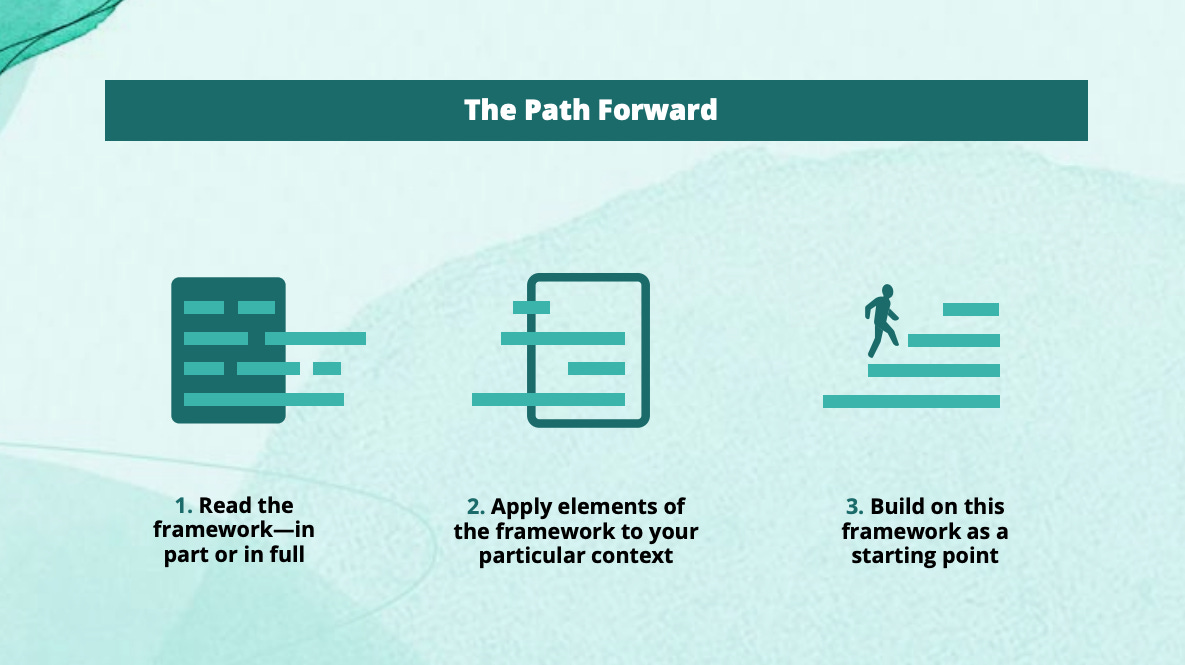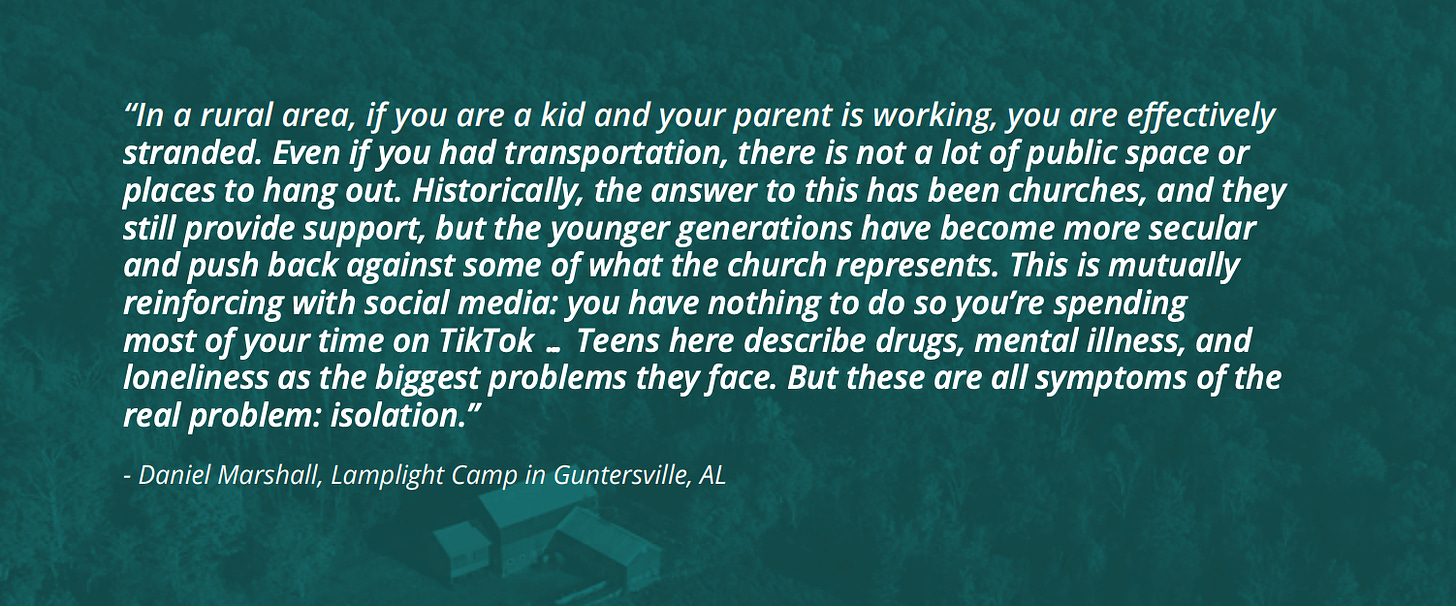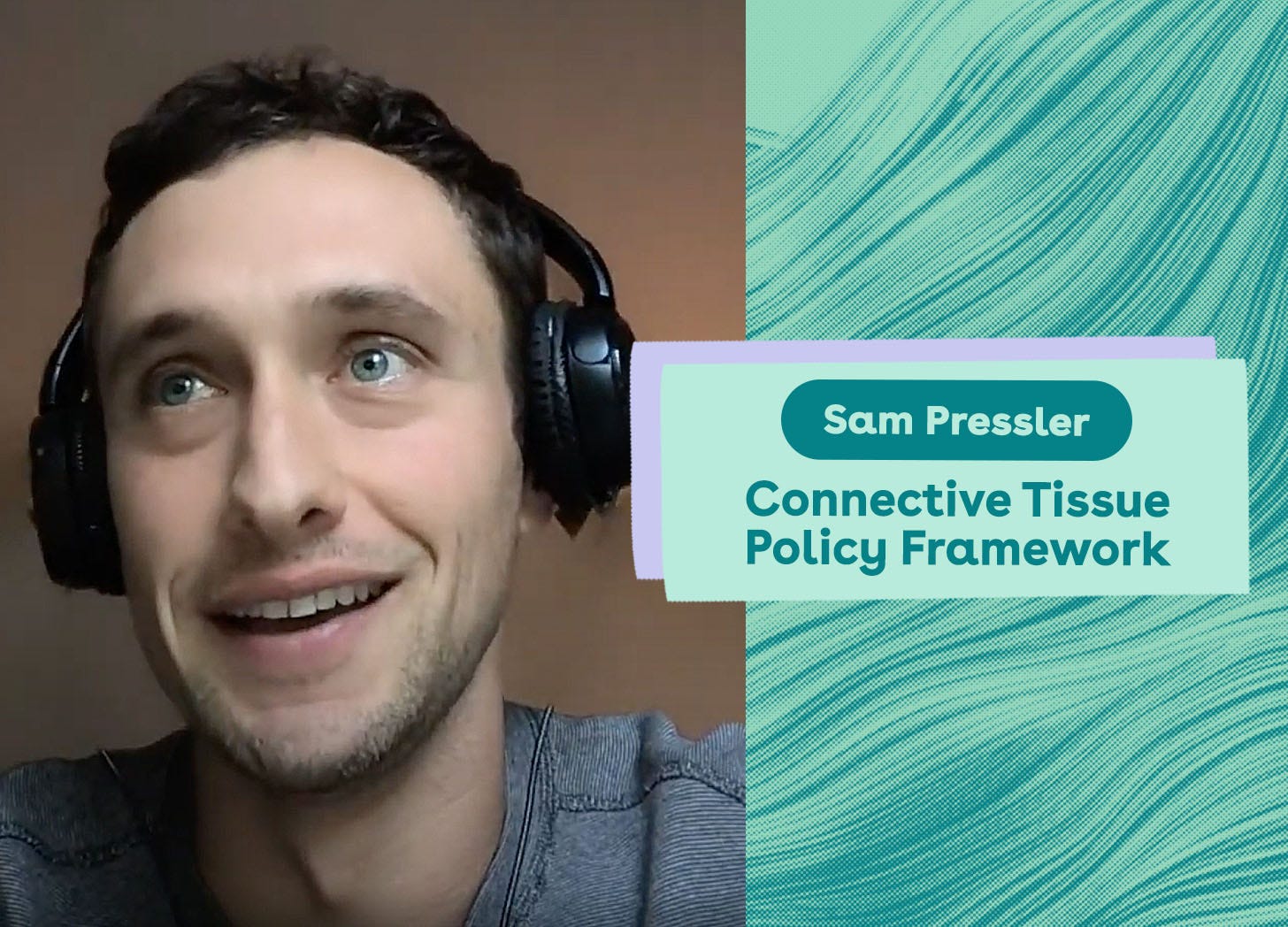🧶🌆 Knitting society back together: A policy framework for civic renewal
Surfing a new wave of communitarianism with Sam Pressler of Connective Tissue
If you haven’t had a chance, explore our new guide for stewards of local digital spaces
If you believe Sam Pressler, a Practitioner Fellow at UVA's Karsh Institute of Democracy and a Research Affiliate at the Harvard Human Flourishing Program, there’s a resurgence of communitarian organizing happening in America. A lot of people and organizations, including New_ Public, are attempting to bring society back together, one club or digital forum at a time.
It can be easy to get tunnel vision about what New_ Public is trying to do: empowering stewards of local digital spaces and working with public media orgs to reconceptualize public conversation — reimagining social media through specific R&D projects.
But when you step back and see the whole forest, there’s a broader social connection movement. Sam has created a framework and database exploring various policies and initiatives for affecting change at national, state, and local levels.
In our conservation below, we explore the costs of “civic deserts,” how college has become a dividing line between Americans, and how social media and local news set the table for everything else. For more along these lines, check out Sam’s excellent Connective Tissue newsletter.
– Josh Kramer, New_ Public Head of Editorial
How Sam learned the value of community and purpose:
I was a 20-year-old college student at William & Mary and I started a stand-up comedy class for veterans. It's a long story, but one thing led to the next, and eventually that one class blossomed into this national nonprofit, the Armed Services Arts Partnership, or ASAP, which is all about helping veterans and their families integrate into their communities using arts as the hook to do that. And through that process, our community members are developing a new sense of purpose and meaning in life, a broader sense of camaraderie and belonging, and new and translatable skills to take into civilian life.
People who did not know each other on the front end of an eight week stand up comedy class, or writing class, or whatever it may be, by the end of the class, not only were they deep friends, but they would show up to support each other unconditionally — well beyond the confines of that single class or program.
After I handed that organization off at age 27, I asked myself, “What the heck just happened? How did I, a civilian who isn’t much of an artist, become the face of the nation’s preeminent veterans arts organization?” I was fortunate to get a fellowship at Harvard — which is a sentence I never thought I’d say — and that offered this generative space to unpack what just happened. I did a lot of reading in the social sciences — looking at Bob Putnam’s and Raj Chetty’s and Theda Skocpol’s work — but also more on the spiritual side, reading people like Thomas Merton and Rabbi Abraham Joshua Heschel for the first time. And, eventually, I reached this “aha” moment, where I realized that all of this work — with ASAP, with my research — was about this question of, “How do we connect or reconnect people to the communities, commitments, and connections that make our lives worth living?”
What led to the Connective Tissue policy framework:
In building this policy framework, I tried to take the intangible and ineffable and make it practical and tangible. This journey has now been a year of talking to over 70 policy makers, practitioners, academics, and think tank folks, to get their sense of this from both the problem definition side and from the solution side — all while conducting desk research of my own. Then translating this research into a framework that could be accessible to policymakers across levels of government, across place, across political persuasions, and providing practical policy opportunities that can be acted upon.
So the framework literally covers everything from housing and neighborhoods and community institutions, to technology and local news — really thinking about all the different ways in which policy can play a role in regenerating connection within communities. I'll just note I left this experience with a deeper belief than I had at the start that policy is not a driver of this, it is actually somewhat of a lagging indicator. And the main reason we're even able to have a policy conversation right now is because civic and cultural change has enabled and opened up a kind of Overton window for us to consider the role policy can play. That comes with opportunity, and it also requires a clear-eyed understanding of the potential and limitations of where policy can fit into this work.

What happens in places with less civic opportunity?
This is somewhat drawing on recent research from Milan de Vries, Jae Yeon Kim, and Hahrie Han, but we now have a very unequal geography of civic opportunity, where you have some places that are abundant and rich with the outlets for civic participation in community life, and others where it has declined. Some places have become civic deserts, where you don't even have many options to participate.
You can think of the potential implications as sequential, if not causal: If you have fewer opportunities to engage in civic life, it's likely that you're going to then participate in civic life less often. And as a result, it's likely that you're going to have fewer relationships. And as a result of having fewer relationships, you're actually going to have less exposure to new civic opportunities in which to participate, because oftentimes the number one driver of community involvement is having a friend, family member, or neighbor say, “hey, come out and do this thing with me.”
A very practical “so-what” of this — and Dan Cox and I, at the Survey Center on American Life, just published a pretty big report on this — is that the college degree has become the dividing line for social support in life.
Americans without degrees have less control over their time, are less likely to live in places with abundant civic opportunities, and oftentimes have fewer financial resources. You see this pattern of cumulative and compounding social disadvantage that starts in childhood, goes through the adult transition, and ends in adulthood, which has contributed to significant gaps in participation and connection in civic life.
Between people who have college degrees and those who don’t, we see a 20 percentage point difference in terms of, do you have multiple people you can turn to who can loan you two hundred dollars? Do you have multiple people you can turn to for a place to stay if you need it, or to listen to you when you're experiencing challenges, or for childcare if you need it in a pinch? These are practical, day-to-day implications of not having social support.
The costs of widespread civic deserts for people and society:
Then there are also deeply systemic implications of this dynamic. Much has been said of deaths of despair — deaths by suicide, overdose, and alcohol-related illnesses. Isolation and low levels of social capital within places are predictors of these deaths, and the dividing line around deaths of despair is the college degree. Through Raj Chetty’s Social Capital Atlas research, we see that the lack of cross-class connectedness is a key driver of economic inequality. And likewise, having cross-class connectedness during childhood is what predicts economic mobility later in life. And so, to the extent that you have isolation — both overall and between educational groups — it makes it more difficult for lower-income people to realize the “American Dream.”
There's also a good bit of research on the civic and democratic implications of our civic decline. Putnam's initial research, Making Democracy Work, showed that places with less civic opportunity and less robust civic communities are much more susceptible to democratic backsliding. While Putnam was studying Italy, scholars like Tim Carney and Stephanie Ternullo have written about similar dynamics playing out in the U.S. Oftentimes, conversations about democratic backsliding are framed as “people are more likely to support authoritarian leaders.” But I think it’s more of an indication that, in places that have experienced civic decline, there's not much evidence that democracy is working. If you're left alone and detached, you're much less likely to think that our democratic system is working for you. Because it’s not.
When you peel back the onion, the weakening of social connection and civic life is “the thing underneath the thing” for a lot of the issues that we point to in America today.

On social media’s role:
In Bowling Alone and his writings that followed, Putnam implicated television in the decline of civic life: if people are spending four hours a night watching television, they're going to be much less likely to show up to that club meeting. Today, these concerns about television seem quaint. We’re dealing with smartphones, social media apps, and streaming services that are designed by behavioral scientists to keep us on them as long as possible. The business model of these devices and of these platforms is to capture and monetize our attention. Everyone is competing for whatever leisure time we have outside of work.
If you think about the resources behind our Big Tech and media companies compared to, say, the scant funds that our local civic institutions have, our communities are being completely outmatched. And, often, we’re being psychologically manipulated to spend as much of our time as possible in front of our devices and away from people.
From a solutions perspective — and I mentioned this in the framework — the Big Tech and media area was one where the policy space seemed most behind and most outmatched. I did not come across anything deeply meaningful that was trying to get at the root causes of, essentially, an economy built on capturing as much of our attention and leisure time as possible.
A more responsible technology and local media ecosystem would create more fruitful conditions for participating and relating to each other in local civic life. And that makes the job of the person running the local community group, or trying to make their neighborhood more connected, easier. Our media ecosystem is the air we breathe, and if that is polluted, all of our interactions are going to be polluted, and if it's healthy, our interactions are going to be healthier, so it's quite important.
The role of local news:
On the local news side, there are exciting experiments around community media and re-envisioning local news not just to be something that we bring back in its old form, but something that is co-created in a participatory manner by communities.
There are experiments of local community media hubs at libraries and at local high schools and colleges. A reimagined local news ecosystem should not only provide high-quality, locally focused information to communities, but actually approach the creation of that local news as a platform for participation in those communities. In these moments of deep crisis, which local news is clearly in, the seeds of regeneration can be planted. Local news feels like one of those institutions that can be regenerated to genuinely be better than it was when it was at its peak revenue in the 1990s.
How we can reorient tech and media platforms to knit the social fabric back together:
I believe New_ Public is working around two of the more promising solutions to this challenge. The first relates to generating more locally-rooted civic online forums like Front Porch Forum that you highlighted recently in the newsletter. We need more platforms that are locally-rooted: not driven by a business model of maximum engagement and growth like Nextdoor, but rooted in designs and practices that foster cooperation and social trust, and that actually have no need for scale. Their fundamental business and governance models should be aligned to serve the local community rather than serving venture investors who need a 10x-plus return or bust.
Obviously, Vermont is one of the most communitarian states in the US, and Front Porch Forum probably benefited from being started in a place like that. But to me, there's no reason that locally-rooted iterations of the Front Porch Forum model could not be planted in other places. I think those models, that are drawing on the principles of cooperation — that are focused on visibly promoting the friction-full interactions that promote trust instead of the hyper-efficient interactions that promote scale — those examples feel promising for modeling an online life that then translates to more trusting and prosocial in-person interactions.
The other thing I hadn't heard of until I interviewed [New_ Public Co-Director Eli Pariser] for the framework is the work that you are doing to support community stewards. I love this idea of equipping the people who are leading communities of thousands of people to foster dynamics that promote more social trust, more cooperation, and more connection and relationship-building in person. I thought those two models were really exciting.
Who is the target audience for this framework and what happens next?
The first target audience is policymakers. I'm operating on the supposition that we're in a new wave of communitarianism. We had waves in the 1990s, we had waves in the 1960s, we had waves in the early 1900s — what Putnam talks about in The Upswing. We're just not fully recognizing it yet.
In this new wave, we can't draw on our old tools to solve these problems. We need new ways of thinking about policy and imagining what policy can do, and also recognizing its limitations. My friend Pete Davis, who, along with his sister, created the Join or Die film on Bob Putnam, has framed this movement as almost similar to the environmental movement. We have an opportunity to reimagine all the institutions within American life to be oriented toward centering the strength of communities, and the connectedness of individuals within them, as ends in and of themselves, not necessarily an input towards some sort of economic outcome.
For policymakers who want to be oriented towards these reimagined ends of community and connection, everyone's going to be on some sort of continuum, from “I'm just becoming aware of this,” to “I'm Senator Murphy, and I'm thinking about what specific actions I can take, policy-wise.” For this framework, the goal is to provide you — wherever you are in that continuum — with a holistic vision for what this connection agenda could look like and a set of tangible actions and examples to move along to the next step on that continuum.
Eventually, what we want to do is create fields within every sector or institution focused on strengthening connection and facilitate learning across these sectors and institutions. So, what does that actually look like in practice? Within any sector of policy that you're thinking of — be it housing, education, care — you're developing a specific field that articulates a vision and set of policies for how that sector or institution can cultivate connection or social capital within communities.
Concurrently, you're building interdisciplinary engagement and relationships across these sector-specific fields focused on connection. This allows experimentation and learning — particularly at the state and local level — in ways that are responsive to local contexts while breaking down silos to reimagine policy as an enabler of connection within community. This should not be some sort of technocratic, top-down approach that so-called “democracy funders” design behind closed doors from coastal cities. It must be anchored in and committed to principles of participatory small-d democracy.
Thank you Sam!
Checking to make sure I know my polling place and that I’m actually registered to vote,
–Josh





